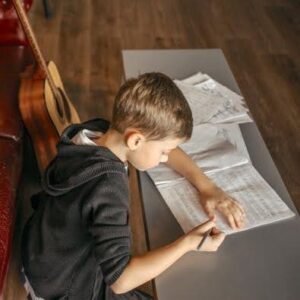Recent changes in Michigan’s educator evaluation laws increase the “say” that teachers have in how they will be evaluated, and for arts educators, these changes serve as reminders of the way the Michigan Arts Education Instruction and Assessment (MAEIA) project have promoted innovative approaches to educator evaluation since its inception.
In November 2024, Michigan’s legislature adopted several key changes to the state’s educator evaluation laws. These changes are included in two pieces of legislation (Public Acts 224 and 225 of 2023) signed into law by the Governor. Each has an effective start date of July 1, 2025.
View a marked-up version of the law as it was passed by the Senate here. Strikethroughs indicate text that was deleted in the final law, while bold text indicates new text that was added in the final versions of it.
Changes to Educator Evaluation Requirements
The most important change in these laws is the new requirement that districts must now agree, through collective bargaining with their employee bargaining units, about several important aspects of educator evaluation.
 Teachers who are organized and bargain with their school systems will now have a say in:
Teachers who are organized and bargain with their school systems will now have a say in:
- What assessments will be used.
- How the assessment information will be applied in their evaluation.
- What educator observation tools are used and how.
The educator evaluation law also made several other changes, while retaining some of the previous requirements. The law:
- Reduced the required contribution of measures of student growth and assessment data in the year-end evaluation from 40% to 20%. This means that there is less emphasis on student assessment information in employee evaluation.
- Added an optional provision for the use of Student Learning Objective (SLO) information in educator evaluation (subject to collective bargaining).
- Reduced the number of categories of educator effectiveness from four categories (highly effective; effective; minimally effective; and ineffective) to three categories (highly effective; developing; and needing support).
- Reduced the requirement for annual appraisals for some educators. Those educators judged to be highly effective or effective (before July 1, 2024) or effective (after July 1, 2024) on their three most recent consecutive year-end evaluations may now be evaluated only once every two (biennial) or once every three years (triennial). If the teacher, however, is not rated as effective on any biennial or triennial evaluations, they must then be evaluated annually.
- The educator observation tool used must be selected from an approved list or it can be locally developed. Evidence of the reliability, validity, and efficacy of the observation tool must be provided for the observation tool to be used. Users must be trained and the plans for providing training to evaluators and observers must be provided.
Innovative Approaches to Educator Evaluation in the Arts
These changes have important implications for educators because of the opportunities they can provide to educators for how and when they are evaluated. This is especially true for arts educators, since there are no commonly available student assessments that can be used to measure student growth in learning in the arts.
 The performance assessments developed by MAEIA (over 360 performance assessments in dance, music, theatre, and visual arts suitable for use at grades K-2, 3-5, 6-8, and 9-12) may now play an increasingly important role in educator evaluation. Each of these assessments measure important state and national arts education content standards, such as performing/presenting, producing, analyzing, and reflecting. The goal of these assessments is to provide teachers with standardized measures of students’ performances in the arts for use in documenting the achievement of students on assessments related to teachers’ instruction. Performance events are one-day on-demand performance assessments, while the performance tasks are multi-day, multi-week assessments.
The performance assessments developed by MAEIA (over 360 performance assessments in dance, music, theatre, and visual arts suitable for use at grades K-2, 3-5, 6-8, and 9-12) may now play an increasingly important role in educator evaluation. Each of these assessments measure important state and national arts education content standards, such as performing/presenting, producing, analyzing, and reflecting. The goal of these assessments is to provide teachers with standardized measures of students’ performances in the arts for use in documenting the achievement of students on assessments related to teachers’ instruction. Performance events are one-day on-demand performance assessments, while the performance tasks are multi-day, multi-week assessments.
In grades K-8, the MAEIA assessments are designed so that arts educators can select a few of these rich, curriculum or instructionally embedded assessments to use to document student achievement periodically throughout the school year.
MAEIA model high school assessments comprise about 150 project-based performance events and performance tasks, many of which have been field tested in Michigan’s classrooms. The goal of these assessments is to provide teachers with standardized measures of students’ performances in the arts to document the achievement of students on assessments related to the teachers’ instruction. The MAEIA model high school assessments are designed for three levels of students: first year, second year, and third/fourth year students in each discipline, in order to provide access to beginning students while challenging the more experienced students.
Local district arts educators may select several MAEIA assessments to use to gauge the extent of changes in student achievement and to show student growth in student achievement, as a result of the instruction provided to students. There are three ways in which the MAEIA assessments may be used in educator evaluation:
Method 1 – Test-Retest within the Same Grade/Same School Year
 In this model, the same MAEIA assessment would be administered twice (or more often) in the same school year, thus measuring change in student achievement from test 1 to test 2. This would permit a rough estimate of how much more students know and/or are able to do by test 2. It is assumed that instruction will take place between test 1 and test 2, and that a roughly comparable item is used each time students are assessed. The items may use the same or similar prompts (e.g., piece of music or work of art). This method may be most appropriate for MAEIA performance events since they usually take only one class period to administer.
In this model, the same MAEIA assessment would be administered twice (or more often) in the same school year, thus measuring change in student achievement from test 1 to test 2. This would permit a rough estimate of how much more students know and/or are able to do by test 2. It is assumed that instruction will take place between test 1 and test 2, and that a roughly comparable item is used each time students are assessed. The items may use the same or similar prompts (e.g., piece of music or work of art). This method may be most appropriate for MAEIA performance events since they usually take only one class period to administer.
Method 2 – Test-Retest Across Adjacent Grade Levels/Adjacent School Years
In this method, the same MAEIA assessment would be given to students twice (or more often), but in adjacent grade levels and adjacent school years. For example, the same students might be assessed in third grade (test 1) and again at fourth grade (test 2). As with Method 1, changes in student performance would be determined from test 1 to test 2. This would permit a rough estimate of how much more students know and/or are able to do by test 2. It is assumed that instruction will occur between test 1 and test 2, and that the same or a roughly comparable item was used each time students are assessed. The intent is to have comparable prompts each time the same assessment is used. This method may be more appropriate for MAEIA performance tasks, since they usually take several class periods to administer, and may be too time consuming to use more than once at a grade level.
Method 3 – The “New Old-Fashioned” Way
In this method, teachers use an assessment at the conclusion of instruction. This one-time use of a MAEIA assessment is most suitable for assessments that are so unique that a “pre-instruction” use of them would leave students confused or uncertain how to respond. This is the “old fashioned way” because this is how testing most often occurs in classrooms. The teacher instructs students on some topic, and then tests them on their understanding of it and/or use of this at the conclusion of instruction.
 For all methods the MAEIA assessments can be used by an arts educator to demonstrate his/her effectiveness by changing the prompt(s) used, if any, and repeating the item one or more times. Sufficient instructional time on the underlying concepts assessed by the item (not the item itself) should occur so that change in student performance is possible. Using the MAEIA assessments in these ways can show student growth in achievement on content standards in the arts that are direct measures of student achievement on important state and national arts education content standards.
For all methods the MAEIA assessments can be used by an arts educator to demonstrate his/her effectiveness by changing the prompt(s) used, if any, and repeating the item one or more times. Sufficient instructional time on the underlying concepts assessed by the item (not the item itself) should occur so that change in student performance is possible. Using the MAEIA assessments in these ways can show student growth in achievement on content standards in the arts that are direct measures of student achievement on important state and national arts education content standards.
The revised legislation specifically added the capability of teacher use of student learning objectives (SLOs) with attendant student achievement measures (both pre and post instruction as well as post instruction only). Thus, if arts educators have previously developed SLOs, or if they wish to develop new SLOs, they may do so and use the resultant information for the growth measure in their evaluation. Many of the MAEIA assessments can be used in this manner.
The freedom to bargain the specifics of educator evaluation provided by the newly revised legislation has re-opened the potential for substantive changes to the model used for teacher evaluation, especially in the arts. Teachers may choose to use the MAEIA assessments to measure student achievement and may request to provide a personal professional practices portfolio or collection of evidence that contains student achievement information, supervisor observations, and a myriad of additional types of data and artifacts. Explore these ideas and be sure to communicate your wishes to your teacher bargaining team so that they can advocate for the teacher evaluation strategies that will promote higher student achievement in the arts.
___________________________________________________________________________________________________________
 ED ROEBER, PH.D., is the assessment director for Michigan Assessment Consortium (MAC) projects. He co-chairs the MAC’s Assessment Resource Development Committee and serves as Board Secretary/Executive Committee.
ED ROEBER, PH.D., is the assessment director for Michigan Assessment Consortium (MAC) projects. He co-chairs the MAC’s Assessment Resource Development Committee and serves as Board Secretary/Executive Committee.
Dr. Roeber has earned degrees in Psychology and Political Science (B.A.) and Educational Psychology/Measurement and Evaluation (A.M. and Ph.D.) from the University of Michigan.
References
Michigan Arts Education Instruction and Assessment. (2016). Using MEAIA Assessments to Demonstrate Educator Effectiveness. Mason, MI: Michigan Assessment Consortium.
Roeber, E. (2014) Alternative Models for Educator Evaluation. Mason, MI: Michigan Assessment Consortium.
Click here for a Printer friendly version of this article.
Leave a Reply
You must be logged in to post a comment. Don't have an account? Register Here.